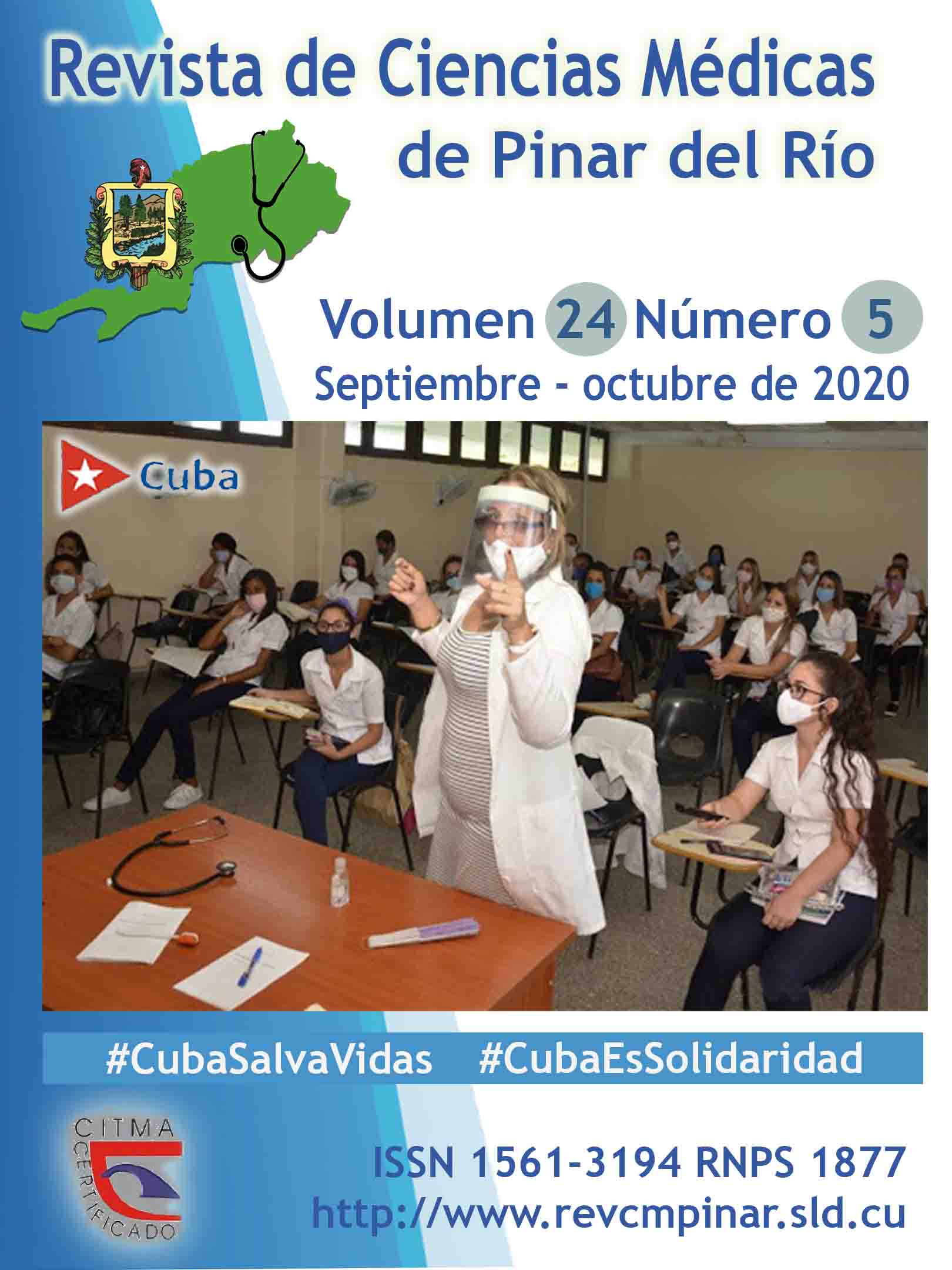Clinical-epidemiological characterization of confirmed COVID-19 patients in Pinar del Río
Keywords:
COMMUNICABLE DISEASES, PANDEMIC, CORONAVIRUS, ADULT, CLINICAL EVOLUTION, SECONDARY CARE.Abstract
Introduction: the study of the characteristics of COVID-19 patients allows the determination of risk groups and specific populations and the strategies designed by the institutions to deal with this situation.
Objective: to characterize clinical and epidemiologically the confirmed COVID-19 patients in Pinar del Río.
Methods: an observational, descriptive, longitudinal and prospective study including the 52 confirmed cases of COVID-19 between March and May 2020 was conducted. Data were collected from clinical records and epidemiological surveys. Descriptive statistics was used.
Results: the age group between 40 and 59 years old predominated (rate of 8,2 per 10 thousand inhabitants), with predominance of male sex (rate of 0,8 per 10 thousand inhabitants). The 94,2 % of the patients presented a precise source of infection at the time of admission. The most frequent symptoms were fever (51,9 %), cough (40,4 %) and rhinorrhea (21,1 %). High blood pressure was present in 11,11 % of the patients, where 35,7 % of hypertensive patients developed acute inflammatory pneumopathy; 86,5 % of the patients were discharged from hospital after 14 days and 96,2 % were epidemiologically discharged after 28 days.
Conclusions: transmission was mostly autochthonous, less asymptomatic, where fever and cough were the main symptoms. Patients with comorbidities developed more complications. A positive response to treatment was found, achieving high percentages of clinical and epidemiological discharge at 14 and 28 days respectively.
Downloads
References
1. Hidalgo MM. Las enfermedades infecciosas: el gran desafío de seguridad en el siglo XXl. Cuadernos de estrategia [Internet]. 2019 [Citado 29/03/2020]; 203:37-80. Disponible en: http://dialnet.unirioja.es/servlet/articulo?codigo=7269522
2. Organización Mundial de la Salud. Foco Técnico: Investigaciones epidemiológicas y clínicas precoces sobre la COVID-19 para una respuesta de salud pública [Internet]. 2020 [citado 05/05/2020]: [aprox. 2p.]. Disponible en: https://www.who.int/docs/default-source/coronaviruse/200223-early-investigations-one-pager-v2-spanish.pdf?sfvrsn=8aa0856_14
3. Corman VM, Landt O, Kaiser M, Molenkamp R, Meijer A, Chu DK, et al. Detection of 2019 novel coronavirus (2019-nCoV) by real-time RT-PCR. Euro surveillance [Internet]. 2020 [Citado 21/03/2020]; 25(3): [aprox. 4 p.]. Disponible en: https://www.ncbi.nlm.nih.gov/pmc/articles/PMC6988269/
4. Almaguer Mederos LE, Cuello Almarales D, Almaguer Gotay D. Rol de los genes ACE2 y TMPRSS2 en la susceptibilidad o gravedad de la COVID-19. Anales de la Academia de Ciencias de Cuba [Internet]. 2020 [citado 25/05/2020]; 10(2). Disponible en: http://www.revistaccuba.sld.cu/index.php/revacc/article/view/799/860
5. Red Nacional de Vigilancia Epidemiológica. Informe sobre la situación de COVID-19 en España. Madrid: Centro Nacional de Epidemiología; 2020. Report No.: 14.
6. Guzmán Del Giudice OE, Lucchesi Vásquez EP, Trelles De Belaúnde M, Pinedo Gonzales RH, Camere Torrealva MA, Daly A, et al. Características clínicas y epidemiológicas de 25 casos de COVID-19 atendidos en la Clínica Delgado de Lima. Rev Soc Peru Med Interna [Internet]. 2020 [citado 29/04/2020]; 33(1). Disponible en: http://revistamedicinainterna.net/index.php/spmi/article/view/506
7. Palacios Cruz M, Santos E, Velázquez Cervantes MA, León Juárez M. COVID-19, una emergencia de salud pública mundial. Rev Clin Esp [Internet]. 2020 [citado 11/05/2020]; [In press]. Disponible en: https://www.sciencedirect.com/science/article/abs/pii/S0014256520300928
8. Ferrer Castro J, Sánchez Hernández E, Poulout Mendoza A. Caracterización clínica y epidemiológica de pacientes confirmados con la COVID-19 en la provincia de Santiago de Cuba. MEDISAN [Internet]. 2020[citado 11/05/2020]; 24(3):473. Disponible en: http://medisan.sld.cu/index.php/san/article/view/3145
9. Acosta G, Escobar G, Bernaola G, Alfaro J, Taype W, Marcos C, et al. Caracterización de pacientes con COVID-19 grave atendidos en un hospital de referencia nacional del Perú. Rev Peru Med Exp Salud Publica [Internet]. 2020 [citado 11/05/2020]; 37(2). Disponible en: http://www.scielo.org.pe/scielo.php?pid=S1726-46342020000200253&script=sci_arttext
10. Sociedad Española de Medicina y Familia Comunitaria. Criterios de atención clínica y de derivación hospitalaria de pacientes diagnosticados como casos probables de infección por SARS-COV-2 [Internet]. 2020 [citado 25/07/2020]. Disponible en: https://www.semfyc.es/formacion-y-recursos/criterios-atencion-clinica-pacientes-covid19/
11. Mizumoto K, Kagaya K, Zarebski A, Chowell G. Estimating the asymptomatic proportion of coronavirus disease 2019 (COVID-19) cases on board the Diamond Princess cruise ship, Yokohama, Japan, 2020. Euro Surveill [Internet]. 2020 [citado 05/05/2020]; 25(10). Disponible en: https://www.ncbi.nlm.nih.gov/pmc/articles/PMC7078829/
12. Bai Y, Yao L, Wei T. Presumed asymptomatic carrier transmission of COVID-19. JAMA [Internet]. 2020 [citado 05/05/2020]; 323(14): 1406-1407. Disponible en: https://jamanetwork.com/journals/jama/fullarticle/2762028
13. Espinosa Brito A. Reflexiones a propósito de la pandemia de COVID-19 [I]: del 18 de marzo al 2 de abril de 2020. Anales de la Academia de Ciencias de Cuba [Internet]. 2020 [cited 14/04/2020]; 10(2): [aprox. 21p]. Available from: http://www.revistaccuba.sld.cu/index.php/revacc/article/view/765/797
14. Vitón Castillo AA, Rego Ávila H, Delgado Rodríguez AE. Consideraciones sobre el manejo de vía aérea y ventilación en el paciente crítico con COVID-19. Rev Ciencias Médicas [Internet]. 2020 [citado 31/07/2020]; 24(3): e4520. Disponible en: http://revcmpinar.sld.cu/index.php/publicaciones/article/view/4520
Downloads
Published
How to Cite
Issue
Section
License
Authors who have publications with this journal agree to the following terms: Authors will retain their copyrights and grant the journal the right of first publication of their work, which will be publication of their work, which will be simultaneously subject to the Creative Commons Attribution License (CC-BY-NC 4.0) that allows third parties to share the work as long as its author and first publication in this journal are indicated.
Authors may adopt other non-exclusive license agreements for distribution of the published version of the work (e.g.: deposit it in an institutional telematic archive or publish it in a volume). Likewise, and according to the recommendations of the Medical Sciences Editorial (ECIMED), authors must declare in each article their contribution according to the CRediT taxonomy (contributor roles). This taxonomy includes 14 roles, which can be used to represent the tasks typically performed by contributors in scientific academic production. It should be consulted in monograph) whenever initial publication in this journal is indicated. Authors are allowed and encouraged to disseminate their work through the Internet (e.g., in institutional telematic archives or on their web page) before and during the submission process, which may produce interesting exchanges and increase citations of the published work. (See The effect of open access). https://casrai.org/credit/



